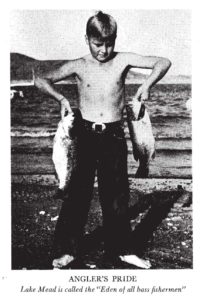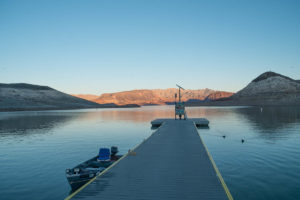One of my favorite bits of business that never made it into my Colorado River book was a late afternoon encounter at Lake Mead’s Boulder Harbor boat ramp with a guy named Scotty. I was thinking about Scotty when I came across the image below, in a 1946 Bureau of Reclamation report on the development of the Colorado River.
The Colorado Basin’s big reservoirs are the best measurement of the health of the hydraulic system on which the region’s farms and cities depend. Two things govern how much water sits in a reservoir – how much nature provides upstream, and how much people remove for use downstream. In the spring of 2015, as I stood at the bottom of the Boulder Harbor boat ramp, that health was not good. Looking up an adjacent hillside, I could see the high water mark more than a hundred vertical feet above me. The lake’s surface elevation, 1,088 feet above sea level, was the lowest it had been in any February since the dam’s federal managers closed its gates and began filling it back in the 1930s. Across the Colorado River Basin, combined storage in Mead and the Bureau of Reclamation’s other reservoirs, which when full hold about four years’ worth of Colorado River flow, stood at just 49 percent.
Scotty moved to Las Vegas after a stint in the Coast Guard and found a nice career supporting the convention industry. He comes down to the lake nearly every week to fish or boat. It is easy for outsiders to get caught up in resentment of Las Vegas, with its “sin city” reputation for gaudy excess, and to question why such our precious water should be squandered on such frivolity. But it is important to remember the Scotty’s of the world. To paraphrase the late Nobel laureate Theodore Schultz, people like Scotty are no less concerned above improving their lot and that of their children than the rest of us.
It was early in the season – late February, still too cold for the bass to be biting – when we talked as he pulled his little aluminum fishing boat out of the water at Boulder Harbor, the nearest boat ramp to his home in nearby Henderson. Henderson is the closest community in the greater Las Vegas metro area to Lake Mead, a quick drive through a treeless desert pass along Las Vegas Wash, around the south side of what the locals call “Sunrise Mountain”. The mountain is part of a treeless desert ridge that separates Las Vegas from a constant reminder of its vulnerability to drought – the great emptiness of Lake Mead.
On the north side of the harbor, against a bank lined with the high marks of old shorelines created as the lake receded, a swarm of ring-billed gulls poked at the water. Scotty pointed to the dipping and diving birds and explained that it was an early sign that the shad, a small non-native fish, were spawning. The bass would soon follow, and fishing season.
Scotty could remember the full days. When he came to Las Vegas in 1997, Lake Mead was more than a hundred feet higher than when we spoke. Locals would drive out the dirt road at Gypsum Wash to a spot where you could jump off a cliff eight feet into water. It used to be a favorite spot for shoreline fishing. Today, the cliff is 80 feet above a sandy wash.
At least Boulder Harbor is still usable. Just up the road, Gail Gripentog-Kaiser, whose family has run marinas and other recreational facilities on the shores of Lake Mead since the 1950s, packed up their floating docks and restaurants in 2002 and moved them to deeper water. A sign on the old the old Las Vegas Bay Marina floating restaurant read “Horsepower Cove or Bust” as the elaborate floating armada squeezed out the narrow neck of Las Vegas wash for a safer harbor.
Recreation brings Scotty to the lake, and gives him a tangible understanding of its decline. But it is the reservoir’s role as water supply to his adopted home, not its recreational value, that gives him pause. Scotty goes on line and tracks snowpack in the Rockies, the same way the water managers do, and talks idly about building a pipeline to the region to bring water from someplace wetter. But he does’t have much hope for a solution. “The writing’s on the wall,” he said. “There’s nothing we can do.”



Wonderful piece of writing. The heritage of Scotty working with less water but keeping faith with his family tradition comes though . Bob